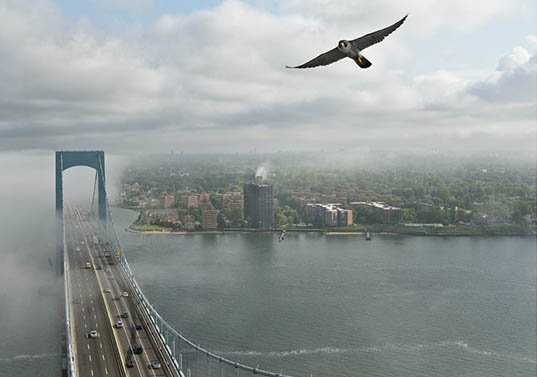The blog was written by Zak Smith, Senior Attorney and International Wildlife Conservation Director of Nature Program, NRDC.
 A Peregrine falcon flying over the Throgs Neck Bridge in New York City ©️Patrick Cashin/Metropolitan Transportation Authority (MTA)
A Peregrine falcon flying over the Throgs Neck Bridge in New York City ©️Patrick Cashin/Metropolitan Transportation Authority (MTA)
A new report from leading biodiversity and climate experts details how humanity must tackle the climate and biodiversity crises together if we want to effectively address either. The report makes clear that our best bet of passing on a maximally livable planet to future generations requires a profound shift in how we look at nature and breaking with destructive ideas around economic progress. In short, we need to prioritize protecting and restoring nature and dismantling the economic systems driving carbon emissions.
The report (the Scientific Outcome of the IPCC-IPBES cosponsored workshop on biodiversity and climate change) details the results of a first-of-its-kind workshop that took place in December 2020 assembled by the Intergovernmental Science-Policy Platform on Biodiversity and Ecosystem Services (IPBES)—an independent intergovernmental body assessing the science and policy related to the conservation and sustainable use of biodiversity—and the Intergovernmental Panel on Climate Change (IPCC)—the United Nations body for assessing the science related to climate change. Fifty experts had a four-day virtual workshop discussing the economic activities driving the biodiversity and climate crises and how solutions to both crises can be mutually reinforcing.
Workshop experts examined how the natural world, from the ocean to our vast forests, plays a pivotal role in combatting the climate crisis by doing things like absorbing nearly 50 percent of carbon dioxide from human emissions. And they explored how climate stability strengthens the natural world, rendering it more able to support wildlife and the life support systems on which we depend, providing things like clean air, clean water, food security, flood control, and carbon sequestration. They concluded that both need and support each other: a stable climate needs and supports thriving ecosystems and thriving ecosystems need and support a stable climate. But, as countries imposed an unsustainable economic system on people and valued nature’s destruction over its maintenance, they disrupted this balance and produced the interconnected crises we face today.
The report is fascinating, hopeful, and scary. It’s something that people working on the climate crisis and people working on biodiversity loss should absorb and sit with for a while—but not too long, the report makes clear too that we’re running out of time.
Here are my five top takeaways:
We need to trash 200+ years of economic thinking and make way for something better. For more than 200 years countries have imposed an unsustainable and destructive economic system on the globe, one that continually reinforces long-held views that the natural world exists to be exploited. That must stop. As Prof. Hans-Otto Pörtner, co-chair of the Scientific Steering Committee that put together the workshop stated, “The evidence is clear: a sustainable global future for people and nature is still achievable, but it requires transformative change with rapid and far-reaching actions of a type never before attempted, building on ambitious emissions reductions. [This] will entail a profound collective shift of individual and shared values concerning nature—such as moving away from the conception of economic progress based solely on GDP growth, to one that balances human development with multiple values of nature for a good quality of life, while not overshooting biophysical and social limits.”
We must stop destroying and degrading carbon- and species-rich ecosystems and instead restore them. Forests, wetlands, peatlands, grasslands, savannahs, mangroves, salt marshes, kelp forests, seagrass meadows, and deep water and polar blue carbon habitats play a vital role in sequestering carbon and support an incredible amount of the planet’s species. We must prioritize their protection and restore those that have already been lost and degraded to effectively combat the climate and biodiversity crises. And, as an extra benefit, restoration also provides jobs and livelihoods.
Conservation actions need to get bigger. Just as Chief Brody tells Quint, “You’re gonna need a bigger boat” in the movie Jaws, we’re gonna need bigger conservation actions. The report notes that “[g]lobal estimates of exact requirements for effectively protected and conserved areas to ensure a habitable climate, self-sustaining biodiversity and a good quality of life are not yet well established but range from 30 to 50 percent of all ocean and land surface areas.” But it also notes that we’re far from that goal, with protected areas currently representing about 15 percent of land and 7.5 percent of the ocean. That’s why NRDC supports the 30x30 movement, the global movement to protect at least 30 percent of land and inland water areas and 30 percent of ocean areas by 2030. We need to protect more land, inland water, and ocean areas and we need to do it fast.
Governments need to stop subsidizing the destruction of biodiversity. The top two drivers of biodiversity loss—land- and ocean-use changes and direct exploitation of species are subsidized by governments. Things like deforestation, over-fertilization, over-fishing, and—of course—fossil fuel development are horrible for biodiversity and climate change and they’re all supported by government subsidies. This must stop.
We must reject false climate change solutions, like planting vast bioenergy crops and irresponsibly planting trees over large areas. The report concludes that “[m]itigating climate change by devoting vast land areas globally to reforestation and afforestation…should be considered unsustainable,” because they can be “detrimental to existing ecosystems’ carbon storage, water balance, biodiversity, and even reduce food security.” In addition, the report finds that bioenergy production—along with carbon capture and storage—on a scale large enough to allow a slower rate of decarbonization will have significant consequences for biodiversity and ecosystem services, as land currently supporting natural ecosystems is destroyed and converted to bioenergy.
For a while now, NRDC has been talking about the need to forge a new relationship with nature. We must do so to effectively address the climate and biodiversity crises. This report reinforces that call to action and provides an outline of the kind of transformative change we need to secure the planet for future generations.
————————————————————


